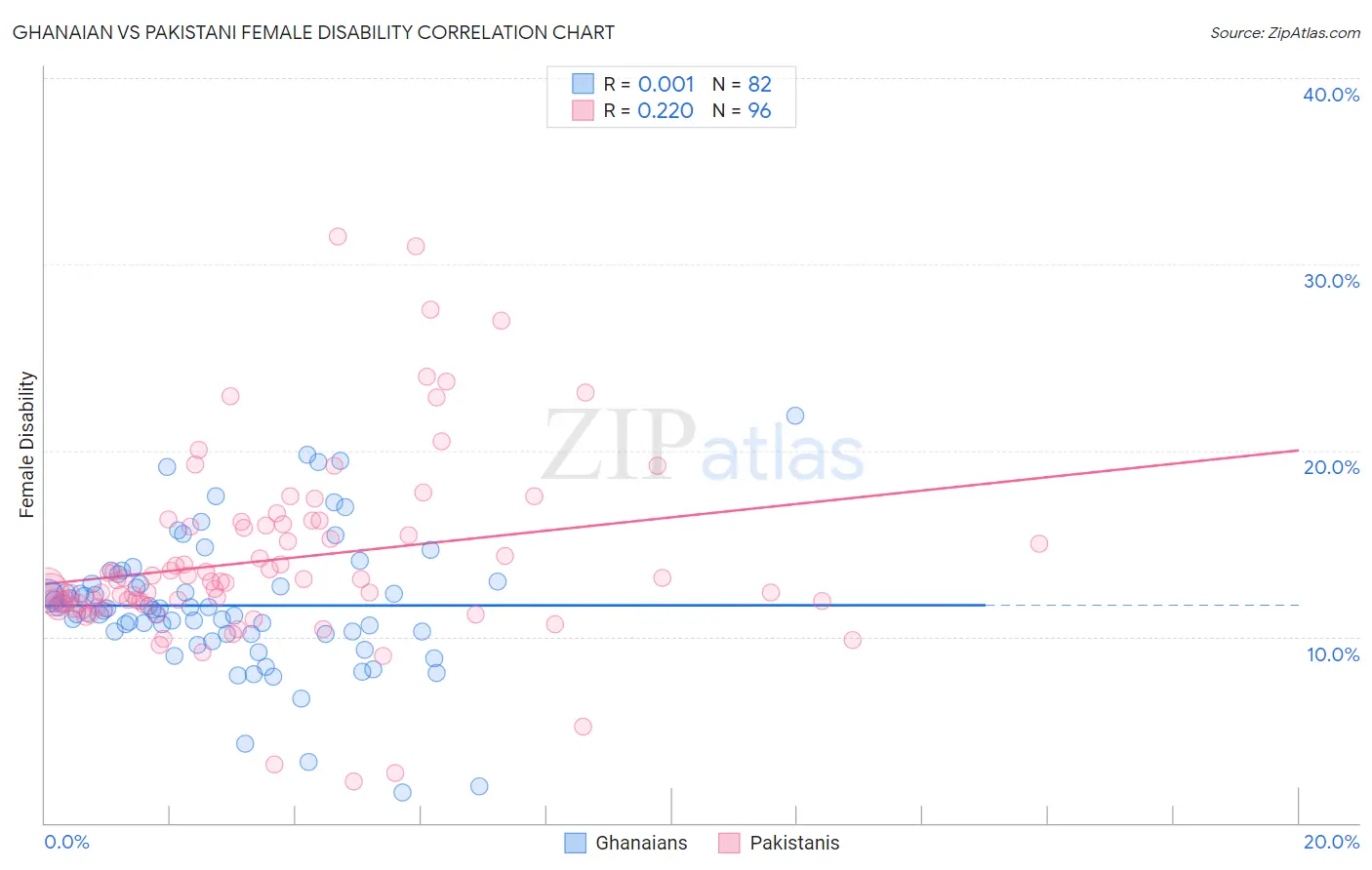Ghanaian vs Pakistani Female Disability
COMPARE
Ghanaian
Pakistani
Female Disability
Female Disability Comparison
Ghanaians
Pakistanis
12.1%
FEMALE DISABILITY
76.6/ 100
METRIC RATING
155th/ 347
METRIC RANK
12.0%
FEMALE DISABILITY
84.6/ 100
METRIC RATING
146th/ 347
METRIC RANK
Ghanaian vs Pakistani Female Disability Correlation Chart
The statistical analysis conducted on geographies consisting of 190,696,570 people shows no correlation between the proportion of Ghanaians and percentage of females with a disability in the United States with a correlation coefficient (R) of 0.001 and weighted average of 12.1%. Similarly, the statistical analysis conducted on geographies consisting of 335,294,894 people shows a weak positive correlation between the proportion of Pakistanis and percentage of females with a disability in the United States with a correlation coefficient (R) of 0.220 and weighted average of 12.0%, a difference of 0.50%.

Female Disability Correlation Summary
| Measurement | Ghanaian | Pakistani |
| Minimum | 1.6% | 2.2% |
| Maximum | 21.9% | 31.5% |
| Range | 20.2% | 29.3% |
| Mean | 11.7% | 14.2% |
| Median | 11.5% | 13.0% |
| Interquartile 25% (IQ1) | 10.2% | 11.7% |
| Interquartile 75% (IQ3) | 12.9% | 16.0% |
| Interquartile Range (IQR) | 2.7% | 4.3% |
| Standard Deviation (Sample) | 3.6% | 5.0% |
| Standard Deviation (Population) | 3.6% | 5.0% |
Demographics Similar to Ghanaians and Pakistanis by Female Disability
In terms of female disability, the demographic groups most similar to Ghanaians are Syrian (12.1%, a difference of 0.020%), Sudanese (12.0%, a difference of 0.14%), Immigrants from Scotland (12.0%, a difference of 0.15%), Moroccan (12.1%, a difference of 0.19%), and Danish (12.1%, a difference of 0.20%). Similarly, the demographic groups most similar to Pakistanis are Nigerian (12.0%, a difference of 0.040%), Immigrants from Kenya (12.0%, a difference of 0.11%), Greek (12.0%, a difference of 0.18%), Immigrants from Moldova (12.0%, a difference of 0.21%), and Estonian (12.0%, a difference of 0.26%).
| Demographics | Rating | Rank | Female Disability |
| Romanians | 91.6 /100 | #140 | Exceptional 11.9% |
| Immigrants | Ecuador | 91.5 /100 | #141 | Exceptional 11.9% |
| Immigrants | Africa | 90.0 /100 | #142 | Excellent 11.9% |
| Immigrants | Sudan | 89.6 /100 | #143 | Excellent 11.9% |
| Immigrants | Austria | 87.9 /100 | #144 | Excellent 12.0% |
| Estonians | 87.8 /100 | #145 | Excellent 12.0% |
| Pakistanis | 84.6 /100 | #146 | Excellent 12.0% |
| Nigerians | 84.0 /100 | #147 | Excellent 12.0% |
| Immigrants | Kenya | 83.1 /100 | #148 | Excellent 12.0% |
| Greeks | 82.0 /100 | #149 | Excellent 12.0% |
| Immigrants | Moldova | 81.4 /100 | #150 | Excellent 12.0% |
| Icelanders | 80.7 /100 | #151 | Excellent 12.0% |
| Immigrants | Scotland | 79.3 /100 | #152 | Good 12.0% |
| Sudanese | 79.1 /100 | #153 | Good 12.0% |
| Syrians | 76.9 /100 | #154 | Good 12.1% |
| Ghanaians | 76.6 /100 | #155 | Good 12.1% |
| Moroccans | 72.9 /100 | #156 | Good 12.1% |
| Danes | 72.5 /100 | #157 | Good 12.1% |
| Immigrants | Middle Africa | 72.4 /100 | #158 | Good 12.1% |
| Immigrants | Central America | 67.7 /100 | #159 | Good 12.1% |
| Immigrants | Guatemala | 66.0 /100 | #160 | Good 12.1% |